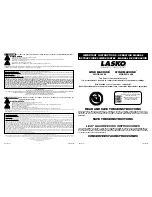
INSTALLATION INSTRUCTIONS
ENERGY RECOVERY VENTILATOR
SERIES TB, TC, TD, TE, TF & TG
Energy recovery COMPONENT certified to the ARI Air-to-
Air Energy Recovery Ventilation Equipment Certification
Program in accordance with ARI Standard 1060-2000.
Actual performance in packaged equipment may vary.
ETL Certified per UL 1995 and CSA 22.2
97B0042N04
Rev.: 15 April, 2016
Installation Instructions For Energy Recovery Ventilator (Fixed)
For Stand Alone Side-by-Side Indoor Application
Inspection
Upon receipt of shipment at the job site, carefully check the
shipment against the bill of lading. Make sure all units have
been received. Inspect the carton or crating housing of each
Rooftop Unit and inspect each unit for damage. Assure that
the carrier makes proper notation of any shortages or damage
on all copies of the freight bill and that he completes a Carrier
Inspection Report. Concealed damage not discovered during
unloading must be reported to the carrier within 15 days of
receipt of shipment.
NOTE: It is the responsibility of the
purchaser to file all necessary claims with the carrier.
Storage
Upon the arrival of equipment at the job site, immediately store
units in a clean, dry area. Do not stack units.
Do not remove
equipment from pallets until equipment is required for
installation.
Unit Protection
Cover rooftop units on the job site. Cap the open ends of pipes.
In areas where painting, plastering, roofing, or the spraying of
fireproof material has not been completed, all due precautions
must be taken to avoid physical damage to the units and
contamination by foreign material.
Physical damage and
contamination may prevent proper start-up and may result
in costly equipment cleanup.
Application
Field supplied balancing dampers in duct are recommended.
Recovery Wheel Mode
The Recovery Wheel mode is accomplished by two blowers
providing continuous exhaust of stale indoor air and
replacement by equal amount of outdoor air. Energy recovery
is achieved by slowly rotating the energy recovery wheel within
the cassette frame work. In winter, the ERV adsorbs heat
and moisture from the exhaust air stream during one half of a
complete rotation and gives them back to the cold, drier intake
air supply during the other half rotation. In summer, the process
is automatically reversed. Heat and moisture are absorbed
from incoming fresh air supply and transferred to the exhaust
air stream. This process allows outdoor air ventilation rates
to be increased by factors of three or more without additional
energy penalty or increase in size of heating or air conditioning
systems.
Rigging Unit For Lifting
1. Maximum weight 300-1200 lbs. See Physical Data Table.
2. Remove crating.
3. All panels must be in place for rigging.
4. Remove barometric exhaust hood from door marked filter
access. Install barometric exhaust hood over exhaust blower
outlet.
5. Forklift channels must be removed from the base of
ERV.
6. Position unit and provide service access to ERV control
access door and wheel.
7. Duct work should be installed into roof curb before installing
ERV on curb.
8. Roof curb gasket must be applied to all top surfaces of the
curb.
9. Position unit on roof curb and provide service access to ERV
control access door and wheel.
�
CAUTION!
�
CAUTION!
Danger of sharp metallic edges. Can cause
injury. Take care when servicing unit to avoid accidental
contact with sharp edges.
�
WARNING!
�
WARNING!
Electric shock hazard. Can cause injury or death.
Before attempting to perform any service or maintenance,
turn the electrical power to unit OFF at disconnect switch(es).
Unit may have multiple power supplies.
�
WARNING!
�
WARNING!
To avoid equipment damage, do not use these
units as a source of heat during the construction process.
The mechanical components and filters used in these units
will quickly become clogged with construction dirt and debris
which may cause system damage.
�
WARNING!
�
WARNING!
The installation of water-source heat pumps and
all associated components, parts, and accessories which
make up the installation shall be in accordance with the
regulations of ALL authorities having jurisdiction and MUST
conform to all applicable codes. It is the responsibility of
the installing contractor to determine and comply with ALL
applicable codes, regulations and ANSI/NFPA No. 70


































